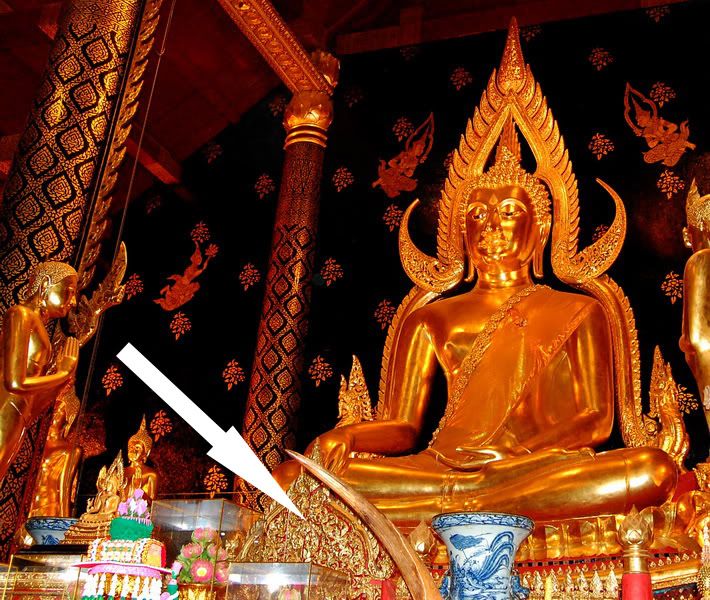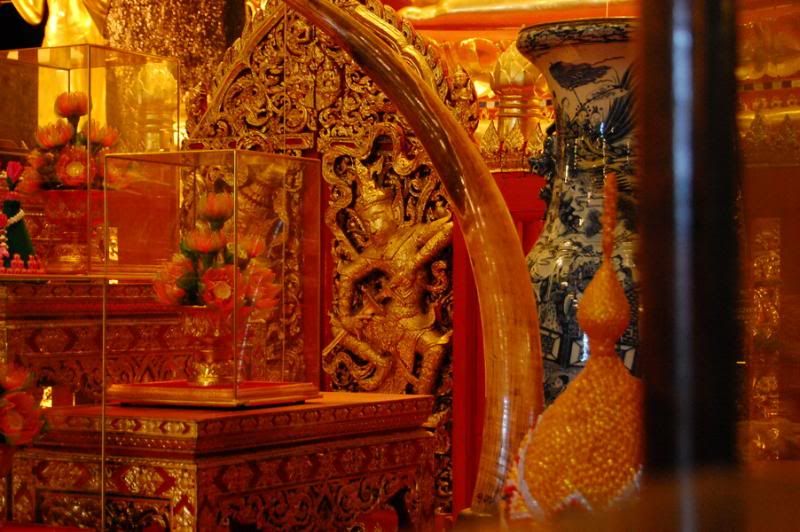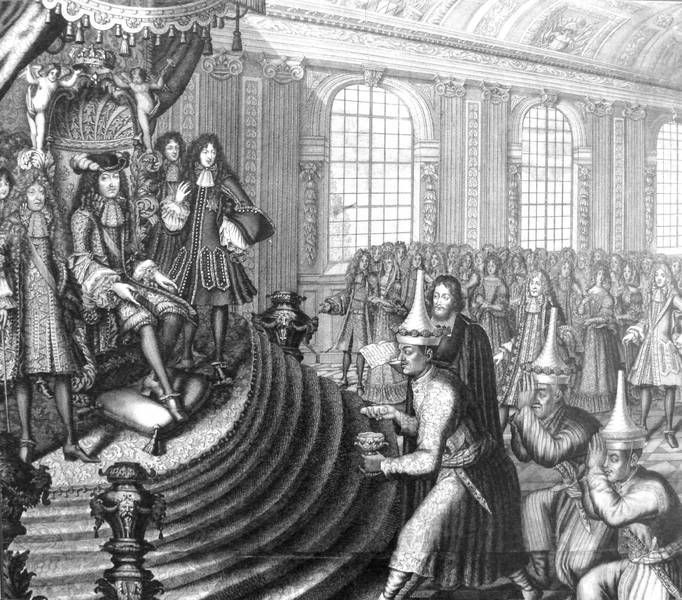
 |
|
|
#1 |
|
Member
Join Date: Aug 2007
Posts: 865
|
Hello all,
I haven't been in the Kreis section that much, but I was wondering if there is much known/ examples discussed on Thai Kreis. Thai Kreis of course have their influence from the Malay peninsula in the southern part of Thailand. Also I didn't know if there are any Thai forum members here that contribute to the Kreis section? I know there are some Malaysian forum members in the Kreis section. There are a couple of Thai who contribute to the Ethnographic section. Here are some links from a Thai forum where they are discussing Kreis...some of the photos they carry from this forum for discussion...I just wondered if they contribute vise versa...take a look as their are 20 pages to the first thread and the 2nd link is a continuation of the first thread. http://www.konrakmeed.com/webboard/u...showtopic=2509 http://www.konrakmeed.com/webboard/u...howtopic=11879 It would be interesting to learn how Thai Kreis are similar yet differ from their Malay counterparts. It is always wonderful when we can hear from native forum members of the weapons of interest.  There are some other very interesting Thai weapons aside from the usual sword and similar to many Malay weapons like the badek. Interested to hear from Thai and non- Thai of course all in the purpose of improving the knowledge of all There are some other very interesting Thai weapons aside from the usual sword and similar to many Malay weapons like the badek. Interested to hear from Thai and non- Thai of course all in the purpose of improving the knowledge of all 
Last edited by Nathaniel; 13th June 2010 at 11:23 PM. |
|
|

|
|
|
#2 |
|
Member
Join Date: Aug 2007
Posts: 865
|
Here are some pictures from the KRM forum...from a Thai Buddhist temple Wat Yai in Phitsanulok which is in Northern Thailand...
  
|
|
|

|
|
|
#3 |
|
Member
Join Date: Aug 2007
Posts: 865
|
 Photo labeled the "Siamese Embassy to Louis XIV" Note the Kreis in their Siamese Envoy (photo from KRM) |
|
|

|
|
|
#4 |
|
Member
Join Date: Aug 2007
Posts: 865
|
Picture of the famous Police officer Khun Phantharak Rajjadej from Nakon Si Thammarat whose death at 103, set off an Jatukham Rammathep amulet craze.
 Note: the Kreis in belt and holding the sword in hand. |
|
|

|
|
|
#5 |
|
Keris forum moderator
Join Date: Aug 2006
Location: Nova Scotia
Posts: 7,261
|
Good question Nathaniel and thanks for the pictures and links. Hopefully someone can address your question. It should be noted, just to make sure there is no confusion, that many of the keris being discussed in the Thai thread have their origins in many parts Indonesia, not Thailand.
|
|
|

|
|
|
#6 |
|
Member
Join Date: Mar 2010
Location: 40˚00' N, 83˚00' W
Posts: 52
|
I'm neither Thai nor Malay, but I'll provide some information, as I understand it.
Southern Thailand is ethnically Malay; the Malay sultanate of Pattani was annexed by Thailand as part of the Anglo-Saimese Treaty of 1909. The Thai provinces of Yala and Narathiwat were originally part of Pattani, but were made separate provinces by the Thai government. The semi-independent Malay states of Satun and Songkhla were also annexed. This has repurcussions to this day, as there is much civil unrest in Southern Thailand. As David has noted, some of the keris in the thread are from other parts of the Malay archipelago. However, keris tajong and keris coteng were prominently featured; tajong are considered to have originated in Pattani, and coteng from Songkhla. In particular, the sheer number of coteng in the first thread is impressive. I noticed that a number of the keris in the thread are from members of this site (and presumably originally posted on this site). I've included a map of southern Thailand, along with representative examples of a tajong (with apologies to Kai Wee, although I did 'borrow' the .jpeg from the Thai thread) and a coteng. I don't know anything about the policeman, but I wonder if he's not ethnically Malay? Nakhon Si Thammarat is in the south, less than 100 miles from Songkhla. To the best of my knowledge, ethnic Thais do not have a keris culture. Ethnic Malays living in Thailand, however, do very much have a keris culture. |
|
|

|
|
|
#7 |
|
Member
Join Date: Mar 2010
Location: 40˚00' N, 83˚00' W
Posts: 52
|
Keris tajong
|
|
|

|
|
|
#8 |
|
Member
Join Date: Mar 2010
Location: 40˚00' N, 83˚00' W
Posts: 52
|
Keris coteng
|
|
|

|
|
|
#9 | |
|
Member
Join Date: Aug 2007
Posts: 865
|
Quote:
Thank you for the great information. To answer your question regarding Aj. K. Phan, here is what I found on a website: http://wichaiwos.blogspot.com/2007/0...-rajjadej.html "Khun Phan or known to the buddhists as Ajahn Khun Phan was a well known police officer in Nakhon Si Thammarat. He passed away peacefully on Wenesday, 5th July 2006 at the ripe age of 103. The installation of the famous city pillar at the province was done on his advise. Police Major General Khun Phan's real name is Butr Phantharak. He was born on 18 Feb 1903 in Tha Sala district of Nakhon Si Thammarat. He graduated from the Huay Chorakae Police Academy in Nakhon Pathom in 1929. He was feared by many criminals even if they have 'supernatural' power. Khun Phan single handedly rooted out all the criminal organisations especially in the southern provinces such as Phatthalung and central provinces, Suphan Buri. It was said that during that period, guns were easily accessible to the criminals, however Khun Phan chased after the criminals with nothing except his trusty long sword. With such accomplishment, the title 'Khun' was bestowed on him. He was the last Thai to have such title. In 1960, Khun Phan received the appointment to be the Police Chief of Region 8 and promoted to the rank of Major General. After serving the force for 40 odd years, Khun Phan retired in 1964 and joined the Democrat Party and elected as a Nakhon Si Thammarat MP in 1973. He was survived by 12 children. 8 with the first wife who passed away and 4 with the second wife. His funeral was held at Wat Mahathat Waoramahawiharn at his birthplace. it will be preside by HRH Crown Prince Maha Vajiralongkorn. He was well loved by the people for his honesty and integrity. Khun Phan practised white magic and consecrate amulets for the people." |
|
|
|

|
|
|
#10 | |
|
Member
Join Date: Dec 2004
Location: Singapore
Posts: 1,180
|
Quote:

|
|
|
|

|
|
|
#11 | |
|
Keris forum moderator
Join Date: Aug 2006
Location: Nova Scotia
Posts: 7,261
|
Quote:

|
|
|
|

|
|
|
#12 | |
|
Member
Join Date: Aug 2007
Posts: 865
|
#19
http://www.vikingsword.com/vb/showpo...6&postcount=19 Quote:
|
|
|
|

|
|
|
#13 |
|
Member
Join Date: Aug 2007
Posts: 865
|
[QUOTE=BluErf]The Thai kreises are "Malayan kerises". Present-day Thailand and Malaysia are modern political creations.
 [/QUOTE [/QUOTEYes, borders have changed frequently over history...and within each kingdom several different ethnic tribes who frequently traded, and adapted goods from near and afar. |
|
|

|
|
|
#14 | |
|
Keris forum moderator
Join Date: Aug 2006
Location: Nova Scotia
Posts: 7,261
|
Quote:

|
|
|
|

|
|
|
#15 |
|
Member
Join Date: May 2006
Posts: 7,135
|
The poor old keris.
Everybody wants a piece of him. Guess that's what happens when you become a Rock Star --- everybody wants to claim you for their own. Russell Crowe is an Aussie, John Lennon was a Canadian, and Bob Dylan was born in Ireland --- betcha didn't know all that, didja? The keris originated in the Dong Son Culture? The Dong Son culture was a bronze age culture that existed from about 1000BC to about the beginning of the Current Era. Bronze age. They were skilled bronze casters, and they made little cast bronze daggers with figural hilts, not dissimilar in form to the keris sajen ( keris majapahit). For a long time many people were inclined to believe that the Modern Keris, that is, the keris in the form that we accept now as a keris, originated from the keris sajen:- they believed that the keris sajen was the earliest form of keris. The principal evidence in support of this theory was the finding of a keris sajen under one of the stupas of the Borobudur. It is possible that there is a similar concept at work in the fabric that supported the Dong Son bronze age dagger, and that still supports the keris sajen, however, this must at the present time be considered as a separate development. Rather than the keris sajen giving birth to the modern keris, it is much more likely that the keris sajen came upon the scene later than the keris in its modern form. All the evidence that has been produced to date places the origin of the keris firmly in the early classical period of Jawa, that is, Central Jawa, pre-1000AD. The keris in its modern form appears certain to have developed in East Jawa during the period 1000AD to about 1400AD. During the 14th -15th centuries, the dominant culture in maritime south east Asia was the Majapahit culture. This culture established trade links and political alliances all over S.E.Asia. It is logically probable that given the iconic position of the keris in Majapahit culture, this same culture was primarily responsible for the spread of the keris throughout S.E. Asia. |
|
|

|
|
|
#16 | |
|
Member
Join Date: Aug 2007
Posts: 865
|
Quote:

|
|
|
|

|
|
|
#17 | |
|
Member
Join Date: Aug 2007
Posts: 865
|
Quote:
|
|
|
|

|
|
|
#18 |
|
Member
Join Date: Dec 2004
Posts: 125
|
Nakhon Si Thammarat was also ethnically a Malay kingdom although it was a vassal state of Sukhothai and later Ayuthaya and played a key role in subjugating much of Langkasuka to Tai control. Its Malay name was Ligor (pronounced Luh-GORE). Its traditional weapons are very much part of the Malay world including the rare and beautiful parang Pattalung - a weapon I have only seen but do not have pictures of. Its related to the parang Pattani but has a longer handle and is reminiscent of the panabas.
Ethnic Tai are not keris bearing although there are many war prizes in Bangkok today. Just go to the military museum and you will see many kerises there. Many Malays from Pattani were also re-settled in the Ayuthaya region and remain a distinct minority there today. Most are only partially assimilated into the contemporary Thai identity. The Cham were also reputed to be keris bearing although today no authentic examples have surfaced. |
|
|

|
|
|
#19 |
|
Member
Join Date: Jun 2007
Posts: 401
|
sometimes its not because of "war prizes' alone.... Most Southeast Asians believe in magical properties in many sacred items, keris included....
i would believe the Chief of Police depicted in the photo, bore the keris as "Sipat Kandhel"..... |
|
|

|
|
|
#20 |
|
Member
Join Date: Mar 2010
Location: 40˚00' N, 83˚00' W
Posts: 52
|
I can find no clear evidence regarding Khun Phan's ethnic identity (at least in English); given his apparent Buddhist religion, it's likely he was ethnic Thai. However, the cities of Nakhon Si Thammarat (Ligor), Songkhla, and Patani were all ethnically mixed (Thais, Malays, and Chinese), and in that milieu it is likely he would have viewed the keris as an object of magical power, as PenangsangII has suggested.
It seems clear from both scholarly sources (and the opinions of contributors in this forum) that to the degree keris culture exists within the borders of the Thai nation, it exists because of ethnic Malays who are now part of the Thai state. There are, of course, contemporary Thai collectors of keris, just as there are many collectors of keris in this forum who are not ethnic Malays. |
|
|

|
|
|
#21 | |
|
Member
Join Date: Aug 2007
Posts: 865
|
Quote:
There has definitely been intermarriage between different tribes, religions, etc. Many of us are mixed mutt's  I'm Chinese, Dutch, English & Irish.... Many Thai nationals are have some Chinese blood in them from one side or both. I know many Thai who are mix of several groups...Mon, Lao, Chinese, Thai, Tai Yai, Tai Lue, Hmong, Shan, Malay, Khmer...so then you might find a mix of customs & tools used...plus just even just plan borrowing/ adaptation as many have suggested...if you find a better rat trap, then use it I'm Chinese, Dutch, English & Irish.... Many Thai nationals are have some Chinese blood in them from one side or both. I know many Thai who are mix of several groups...Mon, Lao, Chinese, Thai, Tai Yai, Tai Lue, Hmong, Shan, Malay, Khmer...so then you might find a mix of customs & tools used...plus just even just plan borrowing/ adaptation as many have suggested...if you find a better rat trap, then use it 
|
|
|
|

|
|
|
#22 |
|
Member
Join Date: Dec 2004
Posts: 125
|
I did not mean to imply that the Tai living in Nakhon dont keep and wear keris. For that matter anywhere else. Clearly though they adopted them from the Malays in the south.
|
|
|

|
|
|
#23 | |
|
Member
Join Date: Mar 2010
Location: 40˚00' N, 83˚00' W
Posts: 52
|
Quote:
Historically there has been much intermixing between ethnic groups in the region, at least between Chinese-Thai and Chinese-Malay (as many of you are well aware). I'm not as familiar as to mixing between Thai-Malay, although historical accounts of Nakhon and other cities in the region in the 16th-18th centuries tell of populations "so mixed that visitors had trouble identifying with whom they were dealing." Nakhon at that time period was ruled by ethnic Thai, but the elite were probably bilingual (Thai and Malay), with many high officials of Chinese and Indian extraction. Primary ethnic groups were Thai, Malay, and Chinese. The amulet craze Khun Phan is linked to is, I assume, the Luang Pho Thuat amulet craze. Jory notes that the amulet craze, and the promotion surrounding the affiliated Buddhist temple (Wat Chang Hai in Pattani), are linked to the Thai government's policy of integrating Pattani into the Thai Buddhist heartland. The mention of the keris in the book The Heritage of Thai Culture seems somewhat suspicious in this regard (which is something Alan notes as well). By claiming the keris as having roots in Thailand, the Thai government bolsters its claim over the former sultanates of Pattani and Songkhla and their peoples, not unlike its use of the Luang Pho Thuat amulet craze to reinforce that claim. |
|
|
|

|
 |
|
|